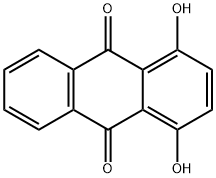1,4-Dihydroxyanthraquinone
Synonym(s):1,4-Dihydroxyanthraquinone;Quinizarin
- CAS NO.:81-64-1
- Empirical Formula: C14H8O4
- Molecular Weight: 240.21
- MDL number: MFCD00001209
- EINECS: 201-368-7
- SAFETY DATA SHEET (SDS)
- Update Date: 2024-12-18 14:08:57

What is 1,4-Dihydroxyanthraquinone?
Chemical properties
orange to red-brown crystalline powder
The Uses of 1,4-Dihydroxyanthraquinone
1,4-Dihydroxyanthraquinone, also known as quinizarin, is of great importance in manufacturing disperse, acid, and vat dyes.
The Uses of 1,4-Dihydroxyanthraquinone
Antioxidant in synthetic lubricants, dyes.
The Uses of 1,4-Dihydroxyanthraquinone
1,4-Dihydroxyanthraquinone is used to color gasoline and some heating oils. It is used as an intermediate for the synthesis of indanthrene- and alizarin-derived dyes. It is also used to form lake pigments with calcium, barium and lead. It may be used in the synthesis of cyclopentanoids by cyclization of α,β-unsaturated aldehyde with 1,4-Dihydroxyanthraquinone. It has been studied as a long range emissive ratiometric fluorescent probe for live cell imaging.
Definition
ChEBI: Quinizarin is a dihydroxyanthraquinone having the two hydroxy substituents at the 1- and 4-positions; formally derived from anthraquinone by replacement of two hydrogen atoms by hydroxy groups It has a role as a dye.
Manufacturing Process
1,4-Dihydroxyanthraquinone is commonly known as Quinizarin.
(a) Boric acid, boric acid and mercury, boric acid and nitrous acid or nitrous acid and mercury in the presence of Anthracene-9,10-dione with sulfuric acid;
(b) In the presence of boric acid and nitrous acid, treated with sulfuric acid 1-Hydroxyanthracene-9,10-dione or 2-Hydroxyanthracene-9,10-dione,
(c)In the presence of boric acid, treated with sulfuric acid 1-Hydroxy-4-nitroanthracene-9,10-dione or 1,4-Dichloroanthracene-9,10-dione;
(d) in the Boric acid and where did in the presence of sulfuric acid, Phthalic anhydride and 4-Chlorophenol ;or Hydroquinone condensation, closed loop.
Synthesis Reference(s)
Synthesis, p. 633, 1974 DOI: 10.1055/s-1974-23387
Tetrahedron Letters, 28, p. 1533, 1987 DOI: 10.1016/S0040-4039(01)81035-2
General Description
1,4-Dihydroxyanthraquinone is an organic dye molecule with an aromatic structure. It is a derivative of anthraquinone bearing hydroxyl moieties. They may find uses in pharmacological, biochemical and dye industries. Anthraquinone dye are resistant to degradation.
Flammability and Explosibility
Non flammable
Safety Profile
Poison by intravenous route. Moderately toxic by intraperitoneal route. Mutation data reported. An eye irritant. A weak allergen. When heated todecomposition it emits acrid smoke and irritating fumes.
Synthesis
At 250 DEG C, heat boric acid 10h, obtain boric acid dehydration compound; Recording boric anhydride in boric acid dehydration compound through ultimate analysis is 99.3%, tetraboric acid 0.7%;In condensation reaction still, add oleum 350kg, phthalic anhydride 120kg, boric acid dehydration compound 40kg, para-chlorophenol 100kg(oleum: phthalic anhydride: metaboric acid: para-chlorophenol=3.5:1.2:0.4:1); Oil bath is warmed up to material 100 DEG C, accurately controls temperature of reaction 100 ~ 105 DEG C, is incubated 0.5 hour; Binder is in the hydrolysis kettle being added with 300L water, and adjustment temperature to 50 DEG C, 50 DEG C of insulations 0.1 hour, discharging press filtration, is washed to neutrality, dries up and obtains 1,4-hydroxyanthraquinone tide product 400.2kg, detect water ratio 54.2%, give money as a gift product 183.3kg, passes through liquid-phase chromatographic analysis, 1, the content of 4-hydroxyanthraquinone reaches 98.74%, dry product purity 97.12%, and yield is 94.1%.
Purification Methods
Crystallise quinizarin from glacial acetic acid. [Beilstein 8 H 450, 8 IV 3260.]
Properties and Applications
orange. Orange red powder. Insoluble in water, soluble in ether, in strong base in certain solubility, but soluble in organic solvent oil, etc. In concentrated sulfuric acid in green yellow fluorescence. Mainly used for oil coloring. Also used in all kinds of plastic and resin, light industry products coloring.
Properties of 1,4-Dihydroxyanthraquinone
| Melting point: | 195-200 °C |
| Boiling point: | 450 °C |
| Density | 1.3032 (rough estimate) |
| vapor density | 8.3 (vs air) |
| vapor pressure | 1 mm Hg ( 196.7 °C) |
| refractive index | 1.5430 (estimate) |
| Flash point: | 222 °C |
| storage temp. | Store below +30°C. |
| solubility | <1g/l |
| form | powder |
| Colour Index | 58050 |
| pka | pK (18°) 9.51 |
| color | red-brown |
| Water Solubility | <1 g/L (20 ºC) |
| Merck | 14,8064 |
| BRN | 1914036 |
| CAS DataBase Reference | 81-64-1(CAS DataBase Reference) |
| NIST Chemistry Reference | 9,10-Anthracenedione, 1,4-dihydroxy-(81-64-1) |
| EPA Substance Registry System | Quinizarin (81-64-1) |
Safety information for 1,4-Dihydroxyanthraquinone
| Signal word | Warning |
| Pictogram(s) |
 Environment GHS09 |
| GHS Hazard Statements |
H410:Hazardous to the aquatic environment, long-term hazard |
| Precautionary Statement Codes |
P273:Avoid release to the environment. |
Computed Descriptors for 1,4-Dihydroxyanthraquinone
| InChIKey | GUEIZVNYDFNHJU-UHFFFAOYSA-N |
1,4-Dihydroxyanthraquinone manufacturer
Vikram And Company
Aayush Aryan Specialities Pvt Ltd
New Products
(S)-3-Aminobutanenitrile hydrochloride 4-Methylphenylacetic acid N-Boc-D-alaninol N-BOC-D/L-ALANINOL Tert-butyl bis(2-chloroethyl)carbamate N-octanoyl benzotriazole 3-Morpholino-1-(4-nitrophenyl)-5,6-dihydropyridin- 2(1H)-one Furan-2,5-Dicarboxylic Acid S-2-CHLORO PROPIONIC ACID ETHYL ISOCYANOACETATE 2-Bromo-1,3-Bis(Dimethylamino)Trimethinium Hexafluorophosphate 4-IODO BENZOIC ACID 3-NITRO-2-METHYL ANILINE 1-(2,4-DICHLOROPHENYL) ETHANAMINE (2-Hydroxyphenyl)acetonitrile 4-Bromopyrazole 5,6-Dimethoxyindanone 2-(Cyanocyclohexyl)acetic acid 4-methoxy-3,5-dinitropyridine 1-(4-(aminomethyl)benzyl)urea hydrochloride 2-aminopropyl benzoate hydrochloride diethyl 2-(2-((tertbutoxycarbonyl)amino) ethyl)malonate tert-butyl 4- (ureidomethyl)benzylcarbamate Ethyl-2-chloro((4-methoxyphenyl)hydrazono)acetateRelated products of tetrahydrofuran








You may like
-
 1,4-Dihydroxyanthraquinone CAS 81-64-1View Details
1,4-Dihydroxyanthraquinone CAS 81-64-1View Details
81-64-1 -
 Quinizarine, 96% CAS 81-64-1View Details
Quinizarine, 96% CAS 81-64-1View Details
81-64-1 -
 1, 4-Dihydroxyanthraquinone, 96% CAS 81-64-1View Details
1, 4-Dihydroxyanthraquinone, 96% CAS 81-64-1View Details
81-64-1 -
 Solvent Orange 86 98% (HPLC) CAS 81-64-1View Details
Solvent Orange 86 98% (HPLC) CAS 81-64-1View Details
81-64-1 -
 Quinizarin,95% CAS 81-64-1View Details
Quinizarin,95% CAS 81-64-1View Details
81-64-1 -
 Quinizarin CAS 81-64-1View Details
Quinizarin CAS 81-64-1View Details
81-64-1 -
 Quinizarin For Synthesis CAS 81-64-1View Details
Quinizarin For Synthesis CAS 81-64-1View Details
81-64-1 -
 1,4-Dihydroxyanthraquinone CAS 81-64-1View Details
1,4-Dihydroxyanthraquinone CAS 81-64-1View Details
81-64-1